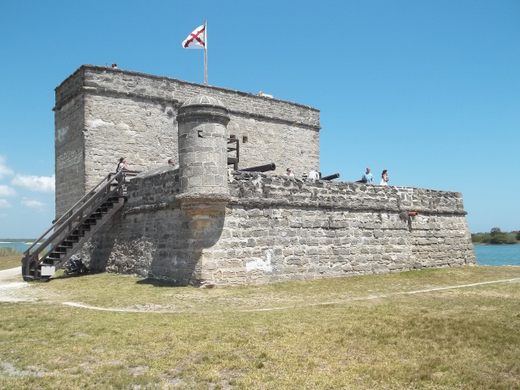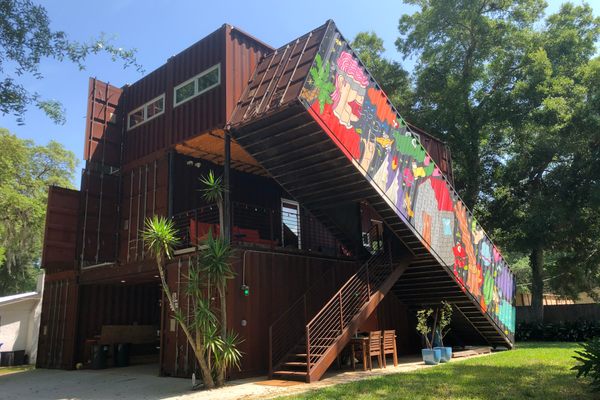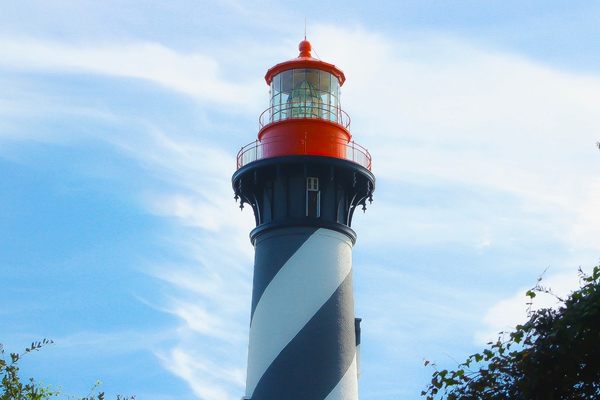AO Edited
Fort Matanzas National Monument
An 18th-century Spanish watchtower made entirely of seashell and concrete.
Florida was settled much earlier by Europeans than New England and many of those settlements are still standing. Few people know that the oldest city in America is St. Augustine, which is just north of Fort Matanzas. For centuries, Florida was owned and occupied by the Spanish, French, and British before it became part of the United States. There were many confrontations between the French and the Spanish as they fought to gain control of the area. The battles were most often fought on the beaches, bays, and rivers and the Matanzas River outlet was the site of one of the bloodiest.
In 1565, the French were sailing off the coast from St Augustine, cruising for a bruising, when a hurricane caught them and made mincemeat of their ships. The 127 French survivors managed to drag themselves to shore, having lost all their weapons, food, and other supplies. They made camp on the sand dunes at a river inlet.
In the meantime, there were 70 Spanish troops a bit further north who had just won a battle with the French and were looking for more scores to settle. The Timucuan Indians told the Spanish about the French survivors and the Spanish troops wasted no time in marching south to go mano-a-mano once again.
The French surrendered immediately when the Spanish arrived. There is some discussion as to whether or not their lives would be spared but, in the end, the Spanish slaughtered 127 and spared 16. Amazingly, the situation repeated itself just two weeks later! At that time, 134 people were killed, which adds up to 261 dead and 16 spared, for a total of 277. Due to bloody fights, the river was named “Matanzas,” which is Spanish for “slaughter” or “killings.” A totally appropriate name.
Contrary to popular belief, Fort Matanzas was not there when the massacres happened. The fort was built about 175 years later. As with most of the other forts in the area, Matanzas was built from coquina, which is a soft stone that comes from the beaches. Coquina consists of crushed and broken seashells that have been compressed over a long period by the weight of the sand and water above. It is easily cut from the sand and, when laid out to air, cures to a cement-like substance.
Fort Matanzas was built as a watchtower to spot enemy ships coming to attack St. Augustine. The very basic housing accommodated only seven Spanish troops. If enemy ships were seen, a messenger was sent north to St. Augustine to warn people at the much larger fort, the Castillo de San Marcos.
The British, however, did take not only St. Augustine but also all of Florida by treaty in 1763. They kept Fort Matanzas as a watchtower, but by 1821, the place was in ruins. On October 24, 1924, the fort was declared a national monument, and nine years later, was transferred from the War Department to the National Park Service. The fort has undergone an extensive restoration and today is a tourist attraction.
Fort Matanzas is only accessible by boat since it’s on an island no larger than two acres, but the seashell fortification is well worth the trip. (The Spanish certainly thought so.)
If you visit Fort Matanzas, take time to visit Washington Oaks State Park, which is a few minutes away, on the other side of the road. On the beach at Washington Oaks, you can often see huge rocks coming up out of the sand and in the breakers. These rocks are coquina stone. Sometimes the coquina stones are quite prominent and stand well above the sand. At other times, there are only a few stones to be seen, here and there. It all depends on the weather as to whether or not the stones are showing as the amount of sand on the beach varies according to the storms. Strong Nor’easters will take sand away from the beach and that’s the best time to visit.
Know Before You Go
About 15 miles south of St. Augustine, on Highway A1A. As you are traveling south (towards Daytona Beach), you'll see a National Monument sign that says "Fort Matanzas". It's just a short drive to the parking lot. The Fort is actually on a very small island, in the middle of the Matanzas River. The National Park has a pontoon boat that takes you across the water to the fort, where a ranger will show you around.
All areas of the Fort Matanzas are free of charge including the ferry to the fort. However, you must stop in the Fort Matanzas Visitor Center (NOT the St. Augustine City Visitor Center) to get your free boarding pass for the ferry. Family members of all ages must have a pass to board the ferry.











































Follow us on Twitter to get the latest on the world's hidden wonders.
Like us on Facebook to get the latest on the world's hidden wonders.
Follow us on Twitter Like us on Facebook